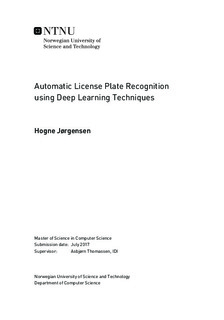Automatic License Plate Recognition using Deep Learning Techniques
Master thesis
Permanent lenke
http://hdl.handle.net/11250/2467209Utgivelsesdato
2017Metadata
Vis full innførselSamlinger
Sammendrag
Context: Automatic license plate recognition (ALPR) is used in many domains, suchas parking, border control and motorway road tolling. Its importance has increasedthe recent years, with many new applications. High prediction accuracy and speed ofALPR is vital. Recent improvements in deep learning have increased its ability to solvecomplex visual recognition task. Using deep learning to improve the accuracy and speedof solving the ALPR task is for this reason promising.
Goal: The goal of this thesis is to propose a method using deep learning techniquessolving the ALPR task and evaluate its processing speed and prediction accuracy.
Method: The research was divided into two stages. The first stage consisted of reviewingpublications on the ALPR task, and reviewing and evaluating deep learningtechniques, aiming at proposing a suitable method. The second stage consisted of evaluatingthe proposed method. The main criteria in the evaluation was processing speedand prediction accuracy. The dataset used to evaluate the prediction accuracy consistedof parked cars with mostly Norwegian license plates.
Results: A method using two object detection convolutional neural networks (CNNs)was proposed for the purpose of solving the ALPR task. The first network was retrainedto detect license plates, and the second network to segment and recognize characterswithin the license plates detected by the first network. Both networks used the YOLOv2architecture, as it was believed to be significantly faster and have slightly higher accuracycompared to the other reviewed architectures. To our knowledge, the proposed methodis new and has never been evaluated on the ALPR task before.The evaluation of the proposed method resulted in an overall prediction accuracy of97.6%, significantly outperforming other methods tested on the same dataset. The licenseplate detection achieved an accuracy of 99.8%, and the character detection anaccuracy of 97.8%. When running the proposed method on a GPU, it used on average17ms to perform plate detection on an image and on average 16ms to perform characterdetection on a plate, giving an overall processing time of 33ms per image. This is to ourknowledge faster than all other methods described in the literature, even substantiallyfaster than most of them. It is also fast enough to run on real-time video streams runningin up to 30 FPS without the need to drop any frames.
Conclusion: This thesis is the first evaluation of a method using deep object detectionCNNs to solve the ALPR task. The proposed method achieved very high predictionaccuracy and outperformed all other methods considering processing speed when usinga GPU. This suggests that using deep object detection CNNs is a good solution for theALPR task.
